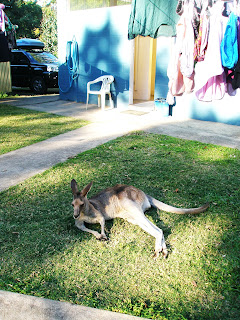Here I sit at our campsite outside Ye Old Buckland Inn, in Buckland, absolutely replete after an evening meal of garlic-marinated mussels, cheeses and fresh apricots . . . all from Tasmania.
We’re still eating and drinking our way around the State, after the usual gargantuan feasts at Christmas. One of Nigel’s colleagues, invited for Christmas lunch, turned up with a huge bowl full of raspberries from his garden, so there has been no shortage of fruits.
John virtually strapped back on his builder’s belt over Christmas to help Nigel build a
hu-u-ge cubby house for 9-year-old Erin. They beavered away at it for a few days to the frame complete, leaving Nigel to start putting on the cladding when we left Smithton on Dec 27. The roof has been ordered but currently is just plastic tarps.
 |
| Erin on the verandah of her cubby house. |
It is so big that Nigel says it will be his doghouse, and Tracey has her eye on it for an art studio when the kids get too big to be interested.
As we’d pretty well ‘done’ the North Coast, we headed south along the Lake Highway, past the great highland lakes . . . and it was freezing! we spent a night deep in a forest clearing beside a babbling river. Lovely!
A highlight was a visit to the Waddamanna Power Station Museum, deep in a valley. It had been Australia’s first hydro-electric power station in 1916 and it is splendid that, although decommissioned, it now hosts an exhibition of the early power stations’ equipment.
 |
| One of the garage-store wall adornments. |
Across more mountain roads we went to the historic Midlands town of Bothwell, settled in the 1820s by mostly Scottish people. This is reflected in the street signs, which all have a tartan background. It was also where, on a property owned by a Scottish chap, Australia’s first golf was played in the 1830s.
The interesting thing was that we had to pay our $15 overnight fee to be in the town campground to the chap in the garage-store, the walls of which are adorned with stuffed deer heads. It’s a huntin’, shootin’ and fishin’ area of Tasmania, with lots of keen fishermen on the lakes and apparently fallow deer are quite feral in the hills around, so that store sells ammo, lots of hunting magazines and even raffle tickets for a five-day sambar deer hunt on the mainland.
Then on we came to the lovely old historic town of Richmond, full of weekend visitors as it’s only a short distance from Hobart, and it was a lovely day.
The ducks under the convict-built bridge must be the best-fed in Australia as lots of kids were throwing bread to them. We walked and walked, visiting the sombre old convict gaol as well as a model of Old Hobart Town, incredibly well done.
In driving around the district . . . stopping to buy cheeses, local chocolate, and the afore-mentioned mussels . . . we noted how terribly dry the hills looked, then took a back road to get to the east coast highway. That’s when we found an orchard selling apricots, for just $4 a kilo so went completely nuts and bought 10kg. Those we don’t eat fresh we’ll stew for desserts and breakfast fruit.
By sheer chance it turned out to be the orchard John had been talking about for weeks. He’d seen a Landline program on ABC-TV ages ago featuring an Aussie couple who’d left the high life as IT experts in Hong Kong to establish an apricot orchard in Tassie, concentrating on supplying the European market at this time of the year. By the look of the huge orchard and the processing shed, it’s all going well . . . and the apricots are wonderful!




































